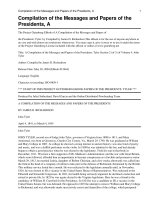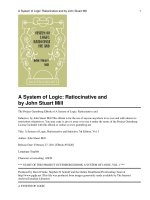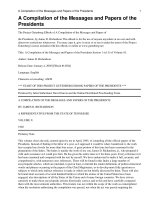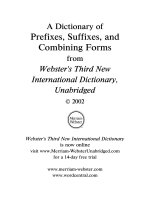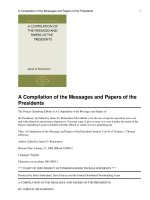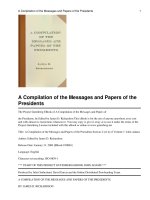Climate-Smart Agriculture: A Synthesis of Empirical Evidence of Food Security and Mitigation Benefits from Improved Cropland Management docx
Bạn đang xem bản rút gọn của tài liệu. Xem và tải ngay bản đầy đủ của tài liệu tại đây (531.58 KB, 43 trang )
Climate-Smart Agriculture:
A Synthesis of Empirical Evidence of
Food Security and Mitigation Benefits
from Improved Cropland Management
CLIMATE
CHANGE
AGRICULTURE AND
FOOD SECURITY
MICCA
MITIGATION OF CLIMATE
CHANGE IN AGRICULTURE
MITIGATION OF CLIMATE CHANGE IN AGRICULTURE SERIES
3
MITIGATION OF CLIMATE CHANGE IN AGRICULTURE SERIES 3
Climate-Smart Agriculture:
A Synthesis of Empirical Evidence of
Food Security and Mitigation Benefits
from Improved Cropland Management
Giacomo Branca, Nancy McCarthy,
Leslie Lipper and Maria Christina Jolejole
Food and Agriculture Organization of the United Nations (FAO)
December 2011
The conclusions given in this report are considered appropriate for the time of its
preparation. They may be modified in the light of further knowledge gained at
subsequent stages of the project. The papers and case studies contained in this
report have been reproduced as submitted by the participating organizations, which
are responsible for the accuracy of the information reported.
The designations employed and the presentation of material in this information
product do not imply the expression of any opinion whatsoever on the part of the
Food and Agriculture Organization of the United Nations (FAO) concerning the legal
or development status of any country, territory, city or area or of its authorities, or
concerning the delimitation of its frontiers or boundaries.
The mention of specific companies or products of manufacturers, whether or not
these have been patented, does not imply that these have been endorsed or
recommended by FAO in preference to others of a similar nature that are not
mentioned. The views expressed in this information product are those of the
author(s) and do not necessarily reflect the views of FAO.
All rights reserved. Reproduction and dissemination of material in this information
product for educational or other non-commercial purposes are authorized without
any prior written permission from the copyright holders provided the source is fully
acknowledged. Reproduction of material in this information product for resale or
other commercial purposes is prohibited without written permission of the copyright
holders.
Applications for such permission should be addressed to:
Chief
Electronic Publishing Policy and Support Branch
Communication Division
FAO
Viale delle Terme di Caracalla, 00153 Rome, Italy
or by e-mail to:
© FAO 2011
iii
Acknowledgements
The authors would like to thank Richard Conant (Colorado State University), MarjaLiisa TapioBistrom
(Food and Agriculture Organization of the United Nations) and Andreas Wilkes (World Agroforestry
Centre) for having read and commented on a previous version of this paper.
This research paper is part of the Mitigation of Climate Change in Agriculture (MICCA) Programme of
the Food and Agriculture Organization of the United Nations in Rome, Italy, funded by the
Government of Finland.
iv
Contents
Abstract v
1. Introduction 1
2. Materials and methods 3
2.1 Dataset 3
2.2 Study designs 5
2.3 Literature review and empirical analysis 7
3. Results 9
3.1 Global trends from the literature review 9
3.2 Evidence from the empirical analysis 14
3.3 Synergies between food security and climate change mitigation 19
4. Conclusions 22
References 24
v
Abstract
Meeting the food demand of a global population expected to reach 9.1 billion in 2050 and over 10
billion by the end of the century will require major changes in agricultural production systems.
Improving cropland management is key to increasing crop productivity without further degrading
soil and water resources. At the same time, sustainable agriculture has the potential to deliver co-
benefits in the form of reduced GHG emissions and increased carbon sequestration, therefore
contributing to climate change mitigation. This paper synthesizes the results of a literature review
reporting the evidence base of different sustainable land management practices aimed at increasing
and stabilizing crop productivity in developing countries. It is shown that soil and climate
characteristics are key to interpreting the impact on crop yields and mitigation of different
agricultural practices and that technology options most promising for enhancing food security at
smallholder level are also effective for increasing system resilience in dry areas and mitigating
climate change in humid areas.
1
1. Introduction
Agriculture is the most important economic sector of many developing countries. Agricultural
production systems are expected to produce food for a global population that will amount to
9.1 billion people in 2050 and over 10 billion by the end of the century (UNFPA 2011). To secure and
maintain food security, agricultural systems need to be transformed to increase the productive
capacity and stability of smallholder agricultural production. However, there is a question of which
technologies and practices are most appropriate to reach this objective, and considerable discussion
about the inadequacy of the dominant model used for intensification so far—relying on increased
use of capital inputs such a fertilizer and pesticides. Generation of unacceptable levels of
environmental damage and problems of economic feasibility are cited as key problems with this
model (Tillman et al. 2002; IAASTD 2009; FAO 2010a). Greater attention is thus being given to
alternative means of intensification, particularly the adoption of sustainable land management
(SLM) technologies.
1
Key benefits of these technologies are increasing food production without
further depleting soil and water resources (World Bank 2006), restoring soil fertility (IFAD 2011; Lal
1997), increasing the resilience of farming systems to climatic risk, and improving their capacity to
sequester carbon and mitigate climate change (CC) (FAO 2009; FAO 2010c).
SLM technologies can generate both private and public benefits and thus constitute a potentially important
means of generating “win-win” solutions to addressing poverty and food insecurity as well as
environmental issues. In terms of private benefits to farmers, by increasing and conserving natural capital –
including soil organic matter, various forms of biodiversity, water resources – SLM can generate productivity
increases, cost decreases and higher stability of production (Pretty 2008; 2011). SLM practices contribute to
improving soil fertility and structure, adding high amounts of biomass to the soil, causing minimal soil
disturbance, conserving soil and water, enhancing activity and diversity of soil fauna, and strengthening
mechanisms of elemental cycling (Woodfine 2008). This in turn translates into better plant nutrient content,
increased water retention capacity and better soil structure, potentially leading to higher yields and greater
resilience, thus contributing to enhancing food security and rural livelihoods (FAO 2009).
At the same time, widespread adoption of SLM has the potential to generate significant public
environmental goods in the form of improved watershed functioning, biodiversity conservation and
CC mitigation. The technical potential for mitigation from agriculture by 2030 is estimated to be
between 4,500 MtCO
2
e/year (Caldeira et al. 2004) and 6,000 MtCO
2
e/year (Smith et al. 2008), which
can be reached by reducing GHG emissions – of which agriculture is an important source
representing 14% of the global total – and increasing soil carbon sequestration – which constitutes
89% of agriculture technical mitigation potential
(IPCC 2007).
2
Many SLM technologies can increase
the levels of soil organic matter, of which carbon is the main component, therefore delivering
significant CC mitigation co-benefits in the form of reduced GHG emissions and increased carbon (C)
sequestration.
3
Improving productivity would also reduce the need for additional land conversion to
1
According to the UN Earth Summit of 1992, SLM is “the use of land resources, including soils, water, animals and
plants, for the production of goods to meet changing human needs, while simultaneously ensuring the long-term
productive potential of these resources and the maintenance of their environmental functions”. SLM comprises four
main categories of land management technologies: improved cropland management, improved pasture and grazing
management, restoration of degraded land, and management of organic soils.
2
To a lesser extent, improvements in rice management and livestock can reduce CH
4
emissions, providing an
additional 9% of mitigation potential. Adopting measures in crop management could reduce N
2
O emissions from
soils, representing the remaining 2% of agriculture’s mitigation potential.
3
The SOC content is likely to reach its maximum 5 to 20 years after adoption of SLM practices and remain similar,
under continuous use of SLM practices and similar environmental conditions. The actual rate of SOC sequestration in
an agricultural system depends on soil texture, profile characteristics and climate, ranging from 0 to 0.15 t C/ha/year
in dry and warm regions and 0.10 to 1 t C/ha/year in humid and cool climates.
2
agriculture, which on its own represents almost as much GHG emissions as those directly generated
from agricultural activities (Cerri et al. 2007; Houghton 1999; Lal 2004).
Despite the capacity to generate both public and private benefits, the adoption of SLM practices has
been relatively low globally (FAO 2010a). Thus, there is considerable interest in understanding better
the benefits, costs and barriers to adoption of these practices. The goal of this present work is to
synthesize the evidence base on the yield impacts (e.g. private benefits) of a range of improved
cropland management options, known to have high potential for sequestering soil carbon and thus
contributing to CC mitigation (e.g. public benefits). By assessing the impact of adopting such
practices on the level of food production, this paper also highlights the state of knowledge on where
synergies between food security and CC mitigation in croplands are most likely to be found.
To fully realize these synergies, we also need a better understanding of the costs and barriers faced
by households when deciding to adopt SLM practices. In a separate companion piece, we consider in
more detail household-level studies of adoption of SLM practices, focusing on the costs and barriers
to adoption by farmers and the institutional changes and policy frameworks needed to reduce
transactions costs and barriers to adoption (McCarthy 2011).
The Paper is structured as follows: Section 2 describes data and analytical methods used in this study
(literature review and empirical analysis), Section 3 reports main results, which are then discussed in
Section 4.
3
2. Materials and methods
2.1 Dataset
The present study is based on a review of the existing literature showing the impact of selected
sustainable cropland management mitigation options on the productivity (average yield) of crops.
4
We compiled data from the literature published in English, Spanish and Portuguese, considering the
following set of technologies as reported in IPCC 2007: (i) improved agronomic practices, (ii)
integrated nutrient management, (iii) tillage and residue management, (iv) water management, and
(v) agroforestry (see Table 1).
Table 1. Sustainable cropland management practices considered in the analysis
Management Practices
Details of the Practices
Agronomy
Use of cover crops
Improved crop or fallow rotations
Improved crop varieties
Use of legumes in crop rotations
Integrated nutrient management
Increased efficiency of Nitrogen fertilizer
Organic fertilization (use of compost, animal and green manure)
Tillage and residue management
Incorporation of crop residues
Reduced/minimum/zero tillage
Water management
Irrigation
Bunds/zai, tied ridge system
Terraces, contour farming
Water harvesting
Agroforestry
Live barriers, fences
Crops on tree-land
Trees on cropland
Source: IPCC 2007
To be included in the analysis, studies had to report: the specific improved cropland management
practice (or group of practices) adopted; the crop on which the practices have been implemented;
and the corresponding change in crop yield. Reporting of variability data (min-max or range, variance
or standard deviation) was preferred but not essential. Only studies reporting empirical results from
wider implementation at farm level of the selected technologies in developing countries were taken
into account. Thus, publications reporting model estimations or results of plot experiments in
research stations or on-farm field trials and studies related to documented cases in developed
countries were not considered. Studies which do not report any quantitative impact of the SLM
practice on the yields, but only an overall indication of such impact (i.e. if positive or negative) were
also excluded. Reports of projects implementing a set of different practices (technology package)
were excluded as well since it was not possible to isolate the impact of the specific practice on crop
productivity.
4
Grasslands are also a potentially important resource for carbon sequestration. However, the evidence on benefits
to grasslands management in terms of both carbon sequestration and livestock productivity is scarcer than for
croplands (though see Abberton et al. 2010 and Lipper et al. 2007 for a review of empirical evidence on
productivity, and Conant et al. 2001 for a review on carbon sequestration effects). This paper will focus only on
cropland, while acknowledging the potential role of grasslands.
4
The main data source was publicly available published peer-reviewed studies. Literature
searches (mainly in English, but also in Spanish, Portuguese and, some French) were conducted
through the Food and Agriculture Organization of the United Nations (FAO) and the University of
Illinois libraries as well as through search engines such as Google Scholar. The following
electronic databases have been consulted: CAB Abstracts, Science Direct, Science Magazine
Online, ProQuest, Economist Intelligence Unit, World Bank Publications, OECD Publications,
CIRAD (Centre de coopération internationale en recherche agronomique pour le développement)
library and the World Overview of Conservation Approaches and Technologies technology
database (WOCAT 2011). Using the WOCAT database, case studies from the questionnaire of
technologies were extratced, and those which report the effects of the practices on average
yields (quantitative data) were selected. Also, the following journals were systematically
checked: Agriculture, Ecosystems & Environment; Agroforestry Systems; Soil & Tillage Research;
Soil Science; Agricultural Systems. Additional information was collected consulting the Global
Farmer Field School Network and Resource Centre (FFSnet),
5
the FAO database on proven
agricultural technologies for smallholders
6
(TECA) and the FAO Investment Centre (TCI)
electronic library of project documents.
7
Keywords used in the search include, among others: sustainable farming/SLM/improved
agronomic practices/tillage management/water management/agroforestry/pasture
management & crop yields. Key words for the search in Portuguese include: rotacão de
culturas/cobertura do solo/pousio/variedades melhoradas/cultivo minimo/plantio
direto/incorporação de resíduos/cordão vegetado/cordão de pedra/patamar de
pera/reflorestamento conservacionista/estercos/adubacao organica/adubacao verde &
productividade. Key words for the search in Spanish include: cultivos de cobertura/rotación de
cultivo/variedades mejoradas/labranza cero/sebes vivas/cercas vivas/agroforesteria o
agrosilvicultura/estiércol/suministros o abonos organicos & cosechas o rendimientos. Key words
for the search in French include: stratégie amélioration de la fertilité/rotations, successions et
associations cultural/gestión de l’eau/plantes fourrageres et de couverture/paillage/haie vive
antiérosive/productivité.
When a relevant study was found, papers which were cited by the study, as well as papers which
cited the study itself were checked, to obtain as complete set of papers as possible. For each
case study, the following information is reported in the database: detailed description of the
practice(s) adopted, crop(s), location (geography, climate), information about land-use history,
and yield variation with respect to previous conventional agricultural practices.
5
Unfortunately, we could not find useful quantitative data from this source of information. In fact, as shown in a
recent study which reviewed 25 impact evaluations, largely from unpublished sources (van den Ban and Hawkins
1996), in assessing the results of Farmer Field School (FFS) activities, no agreement has yet to be reached as to what
to measure and how to measure it. Nevertheless, almost unanimously, studies have demonstrated notable increases
in rice, cotton and vegetable yields (Braun et al. 2006) consequent to the implementation of FFSs.
6
Such as a technology for which there is evidence that the technology has been used or adopted by target
beneficiaries (farmers), especially in rural areas, and that it can be easily reproduced, shows maturity by successful
application in projects, the information that is available is a public good and has been developed with a participatory
approach, and contributes to the increase in yields by making sustainable use of natural resources (FAO 2011).
7
We examined reports such as: Staff Appraisal Report (SAR), Project Appraisal Document (PAD) and Completion
Report (ICR). Unfortunately, due to a complicated and long consultation procedure, it was possible to extract only a
limited amount of information. Also, in many cases, project documents provided only qualitative information or
reported the impact of the whole technology package, without providing the productivity effect of the single
management practices adopted.
5
Overall, 217 observations from about 160 publications were included in the database for the current
study.
8
The database covers five main management practices – agronomy, integrated nutrient
management, tillage and residue management, water management and agro forestry – applied in
three regions – Asia and Pacific, Latin America and sub-Saharan Africa – 41 countries – Bangladesh,
Benin, Bolivia, Botswana, Brazil, Burkina, Cameroon, China, Colombia, Dominican Republic, DR
Congo, El Salvador, Ethiopia, Ghana, Ghana, Guatemala, Honduras, India, Indonesia, Kazakhstan,
Kenya, Malawi, Mexico, Morocco, Mozambique, Nepal, Niger, Nigeria, Pakistan, Paraguay, Peru,
Philippines, Rwanda, Senegal, South Africa, Sri Lanka, Tanzania, Togo, Uganda, Vietnam, Zambia and
Zimbabwe – and mainly over cereals—maize, wheat, sorghum, millet and teff (see Tables 2 and 3).
Table 2. Dataset description: number of observations by management practice
Management practice
Cereals
Other crops
Total
n.
Agronomy
28
10
38
Integrated nutrient
management
24
7
31
Tillage and residue management
55
15
70
Water management
44
8
52
Agroforestry
20
6
26
Total
171
46
217
Table 3. Dataset description: number of observations by geographical area
Region
Cereals
Other crops
Total
n.
Asia and Pacific
49
10
59
Latin America
32
15
47
Sub-Saharan Africa
90
21
111
Total
171
46
217
2.2 Study designs
The studies used in the current review are essentially journal articles and reports of academic
research, edited books and book sections, and project reports. Although seemingly a large number
of studies are available on the topic – since many articles cite evidence from others – the number of
original field studies is considerably more limited. However, the search was expanded using the
World Overview of Conservation Approaches and Technologies (WOCAT 2011) database which
contains a full range of different case studies documented from all over the world, comprising
datasets on 380 technologies from over 40 countries and reporting original field data as well as grey
literature (thesis, manuscripts and other unpublished work).
Most publications in the database make reference to original project data and report findings from
projects aimed at promoting the adoption of improved cropland practices in a specific area and
implemented by local institutions, often in cooperation with scientists (e.g. Altieri 2001; Edwards
8
The number of observations (data points) does not coincide with the number of publications for two reasons: if the
publication reports a separate analysis for different countries or for more than one crop type, then the
corresponding results were considered as separate cases in the database; in some cases one observation results
from more than one publication (e.g. data reported in WOCAT database of technologies).
6
2000; Erenstein et al. 2007; Garrity 2002; Hine and Pretty 2008; Jagger and Pender 2000; Kassie et al.
2008; Kaumbutho and Kienzle 2008; Pender 2007; Place et al. 2005; Pretty 1999; Scialabba and
Hattam 2002; Sharma 2000; Shetto et al. 2007; Sorrenson 1997; Verchot et al. 2007). Most of these
studies report results of observations over a limited number of years. However, some also report
results of long-term observations: e.g. Sorrenson (1997) analyzed the profitability of Conservation
Agriculture on farms in two regions of Paraguay over ten years.
Some publications report empirical results measured in other studies when building a model (e.g.
Dutilly-Diane et al. 2003), while some others are a literature review: Lal (1987) basically reviews all
advances in management technologies that have proven to be successful within the ecological
constraints of Africa by looking at past studies and literature; Parrot and Marsden (2002) and Rist
(2000) generated information through a desk-based literature review, supplemented by a semi-
structured survey of organic organisations, NGOs and academics, and a select number of face-to-
face and telephone interviews; Pender (2007) reviews the literature on agricultural technology
options in South and East Asia, drawing conclusions concerning technology strategies to reduce
poverty among poor farmers in less-favoured areas of this region; Derpsh et al. (2010) report and
comment on results from previous studies on tillage management.
Only in a limited number of cases have results of research experiments been included, specifically in
the case of long-term or worldwide experiments or when a relatively high number of farmers have
been involved: e.g. Govaerts et al. (2007) report the results of a long-term experiment started in
1991 (to 2007) under rainfed conditions in the volcanic highlands of central Mexico, where crop
rotations maize/wheat, zero tillage and residue management practices have been successfully
tested; Hossain et al. (2003) assessed the contributions of international research centres to rice
productivity gains in the developing countries of Asia and Latin America over the period 1965-99,
through a questionnaire and in-depth interviews; Rockstrom et al. (2009) conducted on-farm trials
over 1999-2003 in eight different locations at 11 experimental sites, engaging varying numbers of
farmers at each site.
Unfortunately, in most cases the publications reviewed do not explain clearly how the information
on the effect of the SLM practices on the yields were collected. Only a limited number of studies
used proper impact analysis to document the effect of the introduction of the new technologies. For
example, in the study by CIAT (2008) – aimed at estimating the impacts of new bean varieties
released in eastern, central and southern Africa – the Pan-Africa Bean Research Alliance (PABRA)
coordinated a set of impact studies: field research was conducted between 2004 and 2006 in Kivu
province of DR Congo, Ethiopia, western Kenya, Malawi, northern Tanzania, Rwanda and Uganda,
and data for the country studies was obtained through sample surveys covering 2,476 farm
households. Place et al. (2005) combined qualitative and quantitative analysis: quantitative
measures from surveys, enumerator ratings and farmer self-assessments and qualitative research
methods. Stoll (undated) reported impacts of programmes and projects promoting SLM
technologies. Some studies report the results of surveys conducted among farmers: e.g. Ekboir et al.
(2002) asked an open-ended question about the three most important changes that no-till brought
to farming activities and a majority of the farmers (62%) mentioned higher yields; Erenstein et al.
(2007) used community-level surveys to compare yields from smallholders under conventional
tillage (high-intensity agriculture) and zero tillage in Zimbabwe; Franzel et al. (2004) used
questionnaires to document the results of other report results of farm-led trials conducted after
researcher-led trials.
Most studies report results from single cases in a specific area of a country, and with reference to a
particular climate. However, some studies are a global review of results from various countries: e.g.
Derpsch and Friedrich (2009) compare conservation agriculture systems with conventional tillage
systems in Latin America, Africa and Asia; Hine and Pretty (2008) – which is by far the largest study
7
examining sustainable agriculture initiatives in developing countries – compile the analyses of 286
projects covering 37 million hectares in 57 countries; Pretty (1999) examines a typology of eight
technology improvements currently in use in 45 sustainable agriculture projects in 17 countries,
finding that some 730,000 households have substantially improved food production thanks to cereal
yield increases. Also, some studies report results under different climatic conditions: e.g. Kassie et al.
(2008) use two sets of plot-level data for their empirical analysis in Ethiopia, one from a low rainfall
region (Tigray: 500 farm households, 100 villages, 50 peasant associations and 1,797 plots) and
another from a high rainfall region (Amhara: 435 farm households, 98 villages, 49 peasant
associations and about 11,434 plots).
To isolate the production effects of the improved cropland management technologies, in many cases
the results have been compared with control areas where the practices have not been implemented
(e.g. Erenstein et al. 2007; Franzel et al. 2004; Hellin and Haigh 2002; Hödtke et al. (undated); Li et al.
2008). In other cases, the long-term trends in crop yields have been modelled for several alternative
technology options and compared to crops produced under conventional management practices, on
the basis of extensive farm-experiments (e.g. Garrity 2002, Nelson et al 1998).
In almost all cases included in the literature database, publications have analyzed the results of
peasant farming projects which deal with small-size farms (ranging from less than 1 ha to about
1-2 ha). Only a few cases report results of projects involving medium/large-scale farms: e.g. Alvarez
and Flores (1998) in Honduras; Fileccia (2008) in Kazakhstan; and Sorrenson (1997) in Paraguay.
2.3 Literature review and empirical analysis
We have analysed the effect of adopting improved cropland management technologies on crop
productivity through a traditional literature review – examining the publications collected as
described above – complemented by the analysis of empirical evidence, using the results from the
individual studies contained in the database of publications. The basic assumption underlying the
empirical analysis is that each study result is one observation that can be thought of as one data
point in a larger dataset containing all available observations (Arnqvist and Wooster 1995; Gurevich
and Hedges 1999). A single publication might contribute more than once to the empirical analysis if a
separate study was done for different countries or if more than one crop type was studied.
9
Most of
the studies did not report any measure of variance for the crop yields resulting from the
implementation of the improved practices. Thus, only effects on the average yield have been
considered.
Since the main goal of the empirical analysis was to determine whether the implementation of
various improved cropland management practices elicited quantitatively different responses in crop
yields, we considered the percent change of average yields with respect to the corresponding yield
obtained under conventional agriculture in the same geographical area and under the same climate
conditions. We also tested whether there are significant differences in mean response among
various categories of cropland management technologies (range, standard deviation and coefficient
of variation).
Per each management practice – agronomy, integrated nutrient management, tillage and residue
management, water management, agroforestry – a crop (or group of crops) is selected and the
percentage variation of yield with respect to conventional agricultural practices by agroclimatic
conditions (dry/humid) is examined. Some of the studies report the change in crop yields in absolute
terms (t/ha), while others report data in percentage yield change due to the introduction of
improved practices. To make the results comparable, all data have been transformed into
9
See also footnote 8 above in the text.
8
percentage change with respect to the average yield (using the approximate average yield for the
specific crop and country and under the prevailing climate characteristics of the project area, when
available).
9
3. Results
This section presents the evidence base of the impact of selected improved cropland management
options on crop yields as a result of the literature review (Section 3.1) and of the quantitative
analysis of the empirical evidence (Section 3.2).
3.1 Global trends from the literature review
The main benefit of implementing improved cropland management practices is expected to be
higher and more stable yields, increased system resilience and, therefore, enhanced livelihoods and
food security, and reduced production risk (Conant 2010; Vallis et al. 1996; Pan et al. 2006;
Woodfine 2009; Thomas 2008).
In this next section, we summarize findings from a global literature review on yield effects of the
adoption of specific improved crop management practices. To the extent possible, we distinguish
between agro-ecological and farming system type, as well as long run vs. short run effects. However,
the analysis of these factors is highly constrained by the availability of information in the literature
cited.
Use of cover crops is reported to lead to higher yields due to decreased on-farm erosion and nutrient
leaching, and reduced grain losses due to pest attacks. For example: Kaumbutho et al. (2007)
showed that maize yield increased from 1.2 to 1.8-2.0 t/ha in Kenya with the use of mucuna (Velvet
Bean) cover crop; Olaye et al. (2007) showed that there was a significant yield loss of about
31.4-42.4% in the long run and 36.7-48.5% in the short run for continuous maize planting compared
to maize cropped using different cover crop types—Cajanus spp. (e.g. Pigeon pea) and mucuna;
Pretty (2000) showed that farmers who adopted mucuna cover cropping benefited from higher
yields of maize with less labour input for weeding (maize following mucuna yields 3-4 t/ha without
application of nitrogen fertiliser, similar to yields normally obtained with recommended levels of
fertilisation at 130 kgN/ha); Altieri (2001) reported that maize yields in Brazil increased by 198-246%
with the use of cover crops.
Crop rotations and intercropping designed to ensure differential nutrient uptake and use – e.g. between
crops, such as millet and sorghum and Nitrogen-fixing crops, such as groundnuts, beans and cowpeas –
will enhance soil fertility, reduce reliance on chemical fertilizers, and enrich nutrient supply to
subsequent crops (Conant 2010), leading to increased crop yields (Woodfine 2009). For example, Hine
and Pretty (2008) showed that in the North Rift and western regions of Kenya maize yields increased to
3,414 kg/ha (71% increase in yields) and bean yields to 258 kg/ha (158% increase in yields); Hodtke et al.
(undated), as cited by Parrot and Marsden (2002), report that, in Brazil, intercropping maize with
legumes led to increases in both grain yield and total nitrogen content by 100%.
Increased crop yields after a fallow period have been widely reported (Agboola 1980; Hamid et al. 1984;
Saleen and Otsyina 1986; Prinz 1987; Palm et al. 1988; Conant 2010), although the magnitude of yield
increment after each successive fallow is variable, and bare fallow may increase soil erosion risk.
The use of improved crop varieties is expected to increase average yields because of the greater seed
diversity of the same crop. For example, Pretty (2000) showed that introduction of new varieties of
crops (vegetables) and trees (fruits) increases yields in Ethiopia by 60%; the International Centre for
Tropical Agriculture (CIAT 2008) showed that the average yield increase due to the introduction of
10
new bean varieties in seven African countries was 44% in 2004-2005, although the gains varied
widely across countries, ranging from 2% in Malawi to 137% in western Kenya.
10
Adopting organic fertilization (compost and animal manure) is widely found to have positive effects
on the yields. For example, Hine and Pretty (2008) showed that maize yields increased by 100%
(from 2 to 4 t/ha) in Kenya; Parrot and Marsden (2002) showed that millet yields increased by
75-195% (from 0.3 to 0.6-1 t/ha) and groundnut by 100-200% (from 0.3 to 0.6-0.9 t/ha) in Senegal;
and Scialabba and Hattam (2002) showed that potato yields increased by 250-375% (from 4 to
10-15 t/ha) in Bolivia. Altieri (2001) quotes several examples from Latin America where adoption of
organic fertilization and composting led to increases in maize/wheat yields between 198-250%
(Brazil, Guatemala and Honduras) and in coffee yield by 140% (in Mexico); Edwards (2000) showed
that in the Tigray province of Ethiopia, composting led to yield increases compared to chemically
fertilized plots: barley (+9%), wheat (+20%), maize (+7%), teff (+107%), and finger millet (+3%); Rist
(2000), as cited in Parrott and Marsden (2002), reports that farmers in Bolivia increased potato
yields by 20% using organic fertilizers. Also, enhancing inputs of nitrogen through nitrogen-fixing
plants that are not harvested (green manure) is key to maximizing production and ensuring long-
term sustainability of agricultural systems (Fageria 2007; Hansen et al. 2007). For example, Kwesiga
et al. (2003) showed that in Zambia, including Sesbania sesban (an indigenous nitrogen-fixing tree)
fallow in rotation led to increases in yields for maize with respect to continuous cropping. Maize
yields increased from 6.75 to 7.16 and 7.57 t/ha following 1, 2 and 3 years fallow, showing that short
leguminous fallow rotations of 1-3 years have the potential to increase maize yields even without
fertilizers, thanks to the nitrogen-fixation capacity and mineralization of the belowground root
system.
Increasing the proportion of nutrients retained in the soil – e.g. through mulching and limiting
nutrient leaching – is also expected to have positive effects on crop yields (Smolikowski et al. 1997;
Conant 2010; Silvertown et al. 2006). For example, Lal (1987) reported yield increases by
incorporating residue mulch of rice husks (about 6 t/ha) on different crops—from 3.0 to 3.7 t/ha on
maize, 0.6 to 1.1 t/ha on cowpea, 0.6 to 0.8 t/ha on soybean, 16.4 to 28.3 t/ha on cassava and 10.7
to 17.9 t/ha on yam. Also, soil water contents are generally higher under mulch cover (Unger et al.
1991; Arshad et al. 1997; Barros and Hanks 1993; Scopel et al. 2004).
Tillage systems – which adopt no-tillage, minimum tillage and crop residue management – provide
opportunities for increasing soil water retention. Therefore, crop yields are often higher than under
conventional tillage (Derpsch and Friedrich 2009), especially in semi-arid and dry sub-humid
agroecosystems. For example, substantial increases in rain-use efficiency with implementation of
conservation tillage practices in sub-Saharan Africa are reported by Rockstrom et al. (2009). Studies
examining maize production in semi-arid Mexico produced similar results (Scopel et al. 2005). Also,
in semi-arid areas, no-tillage benefits seem to be higher on severely degraded soils because of low
organic matter content and poor physical conditions (Acharya et al. 1998).
There is also evidence of yield and soil improvements from humid tropical and temperate
agroecosystems (e.g. Rasmussen 1999; Diaz-Zorita et al. 2002; Bronick and Lal 2005), where
primarily minimum and zero-tillage practices are applied. In semi-arid sub-Saharan Africa,
documented success with minimum tillage practices is limited and scattered, largely in relation to
certain development projects, e.g. in Tanzania and Zambia (Rockstrom and Jonsson 1999), even
though significant success has been reported from commercial farms (Oldreive 1993). Conservation
farming success in Africa remains concentrated to more humid environments where many studies
report positive effects on crop yields compared to traditional tillage management: Hine and Pretty
10
New varieties were planted on 49% of total bean acreage in 2004-2005, but the proportion varied across countries
(DR Congo-Kivu 68%, N. Tanzania 56%, Malawi 68%, Rwanda 43%, and Uganda 31%).
11
(2008) report increases in maize yields (+34%) and soya (+ 11%) in Argentina; Hine and Pretty (2008)
record increases in yields of maize (+67%, from 3 to 5t/ha) in ten years and soya (+68%, from 2.8 to
4.7 t/ha) in Brazil (Paraná and Rio Grande do Sul) and again maize (+ 47%), soya (+83%), and wheat
(+82%) in Brazil (Santa Caterina).
Proper water management can help capture more rainfall (Vohland and Barry 2009), making more
water available to crops, and using water more efficiently (Rockstrom and Barron 2007), which are
crucially important for increased agricultural production (Conant 2010; Rockstrom et al. 2010).
Bunds/Zai and Tied Ridge Systems generate higher yields, particularly where increased soil moisture
is a key constraint (Lal 1987). Terraces and contour farming practices can increase yields due to
reduced soil and water erosion and increased soil quality: Altieri (2001) showed that restoration of
Incan terraces has led to 150% increase in a range of upland crops; Shively (1999) finds that contour
hedgerows can improve maize yields up to 15% compared with conventional practices on hillside
farms in the Philippines; Dutilly-Diane et al (2003) reported an increase millet yields from 150-300 to
400 kg/ha (poor rainfall) and 700-1,000 kg/ha (good rainfall) in Burkina Faso; and from 130 to
480 kg/ha in Niger but also note that bunds lead to increased yields in the low and medium-rainfall
areas, but lower yields in the high rainfall area (which had exceptionally high rainfall the year of the
survey). Dosteus (2011) reports that building excavated terraces (bench/fanya juu
11
) in the Ulugurus
mountains in Tanzania has improved soil composition: for example, soil testing results have shown
that the average moisture level in areas with terraces/ fanya juu is higher than in areas without
structures (1.6% vs 0.3%) and average soil compaction is lower than in areas with no terraces
(1.05 km/m
2
vs 3.05 km/m
2
). Consequently, crop performance in areas with interventions has
improved in terms of crop growth rate and yields: maize and beans yields harvested on excavated
structures increased three times. Also, farmers were able to introduce high value crops like tomato,
cabbage and spices (Dosteus 2011). Posthumus (2005) showed that in Peru yields obtained with
bench terraces are higher than yields without terraces for maize in Pachuca (640 versus 408 Kg/ha)
and for potato in Piuray-Ccorimarca ( 3,933 versus 850 kg/ha). However, it is also found that the
yield increase is nullified by the amount of area lost (20%) due to the terracing, which makes it
necessary to fully exploit the terraces (e.g. cultivation of a second crop during the dry season, use of
organic fertilizers, or use of irrigation) in order to counterbalance the production loss (Posthumus
2005).
Water harvesting techniques (e.g. run-off collection techniques, water storage tank construction,
use of devices for lifting and conveying water, microcatchment water conservation with film
mulching) also increase yields: Parrott and Marsden (2002) showed that water harvesting in Senegal
changes the yields of millet and peanuts by 75-195% and 75-165% respectively and that water
conservation techniques resulted in 50% increase in productivity in eastern and central Kenya; Pretty
(2000) report that cereal yields went up more than 100% in Zimbabwe thanks to the implementation
of water harvesting technology.
Agroforestry refers to land use practices in which woody perennials are deliberately integrated with
agricultural crops, varying from very simple and sparse to very complex and dense systems. It
embraces a wide range of practices (e.g. farming with trees on contours, intercropping, multiple
cropping, bush and tree fallows, establishing shelter belts and riparian zones/buffer strips with
woody species etc.) which can improve land productivity providing a favourable micro-climate,
permanent cover, improved soil structure and organic carbon content, increased infiltration and
enhanced fertility (WOCAT 2011) reducing the need for mineral fertilizers (Schroth and Sinclair 2003;
Garrity 2004). For example, Sharma (2000) as cited by Parrott and Marsdem (2002) reports yield
11
A Fanya juu (“throw it upwards” in Kiswahili) terrace comprises embankments (bunds) which are constructed by
digging ditches and heaping the soil on the upper side to form the bunds which are usually stabilized with grass
strips (WOCAT, 2007).
12
increases of 175% on farms in Nepal; Soto-Pinto (2000) studied outputs from shade grown coffee
production in Mexico and found that shaded groves had yields 23-38% higher; Verchot (2007)
reported an increase in maize yields from 0.7 to 1.5-2t/ha in Malawi. Use of live fences is also
expected to increase yields (e.g. Ellis-Jones and Mason (1999) reports increased from 13.5 to
31.7t/ha of cassava yields) although results are controversial: e.g. Hellin and Haigh (undated) reports
no difference in yields from adoption of live barriers/fences. A summary of these findings is reported
in Table 4.
Last, while we do not present detailed results relating to pasture management, it is worth noting
that SLM practices on grasslands can have a positive impact on food security by livestock yields.
Research has documented that improved pasture management by improving vegetation community
structure (e.g. seeding fodder grasses or legumes with higher productivity and deeper roots) can
lead to higher livestock yields due to greater availability of better quality forage with potential
increased returns per unit of livestock (Sleugh et al. 2000; Hussain 2007). Adopting improved grazing
management (stocking rate management, rotational grazing, enclosures to allow degraded pasture
to recuperate) has also the potential to increase livestock yields. For example, Derner (2008) showed
that average daily gains (kg/head/day) decreased with increasing stocking rate and grazing pressure:
heavy stocking rates reduced average daily gain by 16% and 12% compared to light and moderate
stocking rates, respectively. Haan (2007) reported that grazing cattle return to the pasture over 80%
of Phosphorus and other nutrients consumed in forage (Berry et al. 2001), and these nutrients
become available to support forage growth and livestock productivity (Bakker et al. 2004). However,
as noted above, for the most part there is very limited evidence on changes in livestock productivity
from various management options, and even the extent to which there is documented overgrazing
(c.f. the review in Vetter 2009) particularly in semi-arid regions. Thus, we do not delve into these
issues further here.
Table 4. Impact of improved cropland management practices on crop yields: summary of global trends
Practices
Details of the practices
Impacts on Crop Yields
Improved
agronomic
practices
Cover Crops
Higher yields due to reduced on-farm erosion and reduced nutrient leaching. E.g.
Ka
umbutho et al. (2007); Olaye, et al., (2007); Pretty (2000); Altieri (2001)
Crop rotations
Higher yields when cropped, due to increased soil fertility. E.g. Kwesiga et al.
(2003)
Improved Varieties
Increased crop yield. E.g. Pretty (2000); CIAT African Coordination Kawanda Ag
Research Institute (2005); Hine and Pretty (2008)
Use of legumes in the rotation
Higher yields due to increased N in soil. E.g. Hine and Pretty (2008); Hodtke, et al
(undated), as cited by Parrot and Marsden (2002);
Integrated
nutrient
management
Increased Efficiency of N
Fertilizer; organic fertilization;
legumes and green manure;
compost; animal manure.
Higher yields through through increased soil fertility and more efficient use of N
fertilizer. E.g. Hine and Pretty (2008) ; Parrot and Marsden (2002); Scialabba and
Hattam (2002) ; Altieri (2001); Edwards (2000); Rist (2000), as cited in Parrott and
Marsden
Tillage/residue
management
Incorporation of Residues
Higher yields through increased soil fertility, increased water holding capacity. E.g.
Lal (1987)
Reduced/Zero Tillage
Higher yields over long run, particularly where increased soil moisture is valuable.
E.g. Hine and Pretty (2008)
Water
m
anagement
Irrigation
Higher yields, greater intensity of land use. E.g. Khan (2005)
Bunds/Zai, Tied Ridge System
Higher yields, particularly where increased soil moisture is key constraint. E.g. Lal
(1987), Kasie (2008)
Terraces, contour farming
Higher yields due to reduced soil and water erosion, increased soil quality. E.g.
Shively (1999); Altieri (2001); Dutilly
-Diane et al (2003); Posthumus (2005)
Water harvesting
Higher yields. E.g. Parrott and Marsden (2002); Parrott and Marsden (2002), Pretty
(2000)
Agroforestry
Live Barriers/Fence
Higher yields. E.g.: Hellin and Haigh (-); Ellis-Jones and Mason (1999)
Various agroforestry practices
Potentially greater food production, particularly if undertaken on marginal/less
productive land within the cropping system. Greater yields on adjacent croplands
from
reduced erosion in medium-long term, better rainwater management; and
where tree cash crops improves food accessiblity. E.g.: Sharma (2000) as cited by
Parrott and Marsdem (2002); Soto-Pinto (2000) ; Verchot et al (2007)
13
Table 4 summarizes the results of the review by major category of practice. There are three
important trends that emerge from this analysis related to the potential of these practices to be
widely adopted and benefit smallholder farmers as well as the global community.
First, the practices can be adopted in a wide range of different combinations, and this matters very
much for impacts on yields as well as externalities across different locations. It depends very much
on the entire package that is adopted in terms of yield effects Table 5 exhibits the range of practices
in different systems for on location in Brazil – indicating the range of farm effects realized. FAO 2010
and Bassi 2009 provide other examples. This issue of packaging and combining practices is clearly
key to obtaining desired results from SLM adoption and creates difficulties in generating
comparisons across sites and combinations of technologies.
Table 5. Impact of improved cropland management technology packages on crop yields: an example
from Brazil
Profitability of adopting SLM practices:
some examples of improved cropland management in Brazil
Activity
Area
Specific practices
Average
productivity
increase
(%)
Average farm
net
Income
increase
(%)
Project time
horizon
(%)
Millet, soybeans,
coffee, oranges
S.Paulo
Contour cropping, summer and
winter rotation crops, minimum
tillage, IPM
50.3
40.7
10
Maize and other
grains, beans,
banana, cassava
S.Caterina
Conservation agriculture and agro-
forestry
205.0
161.0
15
Cotton, maize,
pastures
S.Paulo
Terracing, minimum tillage, agro-
forestry, integrated nutrient
management
45.5
69.3
5-7
Maize and other
grains
Parana
Vegetative contours, reduced
tillage, terracing, integrated
nutrient management
81.7
104.0
7
Source: FAO-Technical Cooperation Department
A second major issue that arises is the timing of yield effects; short run vs. long run. In many of these
studies, yield benefits emerge only over time: for several options, short-term impacts may be
negative depending on underlying agro-ecological conditions, previous land use patterns, and
current land use and management practices. Yield variability can also increase in the short term
where changes in activities require new knowledge and experience, and farmers unfamiliar with
such systems require a period to successfully adopt the practice (e.g. fertilizer application or the
construction of water retention structures where incidence and severity of both droughts and floods
are expected to increase in the future) (McCarthy et al. 2011; FAO 2009). Long-term impacts are
expected to be positive for increasing both the average and stability of production levels. For
instance, crop and grassland restoration projects often take land out of production for a significant
period of time, reducing cultivated or grazing land available in the short-run, but leading to overall
increases in productivity and stability in the long run (FAO 2009).
Giller et al. 2009 presents data from several field studies of conservation agriculture adoption
indicating a significant lag in yield effects. They also emphasize the importance of specific site
characteristics in influencing yield effects and timing. In areas where soil moisture is a key constraint
on yields, conservation agriculture can have very immediate yield benefits. However, in humid areas
on water-logged soils the same practices could lead to yield decreases.
14
Figure 1. Effect of conservation agriculture practices on crop yields in Nigeria and Zimbabwe
Source: Giller et al. 2009
A final general finding from this analysis is that there are relatively few studies that report decreases
or lack of yield effects. Giller et al. 2009 do report a few for the case of conservation agriculture, but
in general agronomic studies on the adoption of sustainable land management practices report yield
benefits. This finding can lead to two different conclusions: one is that sustainable land management
does indeed have yield benefits across a wide range of practices, agro-ecologies and farming
systems. The second is that studies where sustainable land management did not generate any yield
benefit or actually reduced benefits are much less likely to be published and thus a bias exists in the
literature in terms of our understanding of SLM impacts on yield. This latter conclusion is only
speculation and not based on any evidence, but may be important to keep in mind as a possibility
when assessing the overall conclusions from the literature.
3.2 Evidence from the empirical analysis
The empirical analysis focuses on the effect of the adoption of improved cropland management
practices on the yields of cereals. As for other crops, the number of observations was too limited to
be statistically significant (see Tables 2 and 3 above). Our analysis clearly shows that improved
cropland management increased cereal productivity. Figure 2 reports the average global marginal
increase in cereal productivity with respect to average yield under conventional agriculture (in
percentages). However, not all categories of practices had the same impact on average yield
increases (and on the variability among the average) as shown in Figure 1.
The data in Figure 1 were further analyzed in relation to the predominant climate and to the
geographical area where the practices were adopted.
12
The impact of the adoption of SLM practices
was tested in both dry and humid areas. Results show that agronomy practices, integrated nutrient,
and water management are more effective at increasing crop yields in humid than in dry areas. On
the other hand, the marginal yield increase observed under tillage management and agroforestry
practices is higher in dry areas (Table 6).
12
We also tested if the size of the farm is a variable with some effects on the average yields. As mentioned, most
observations reported in the sample refer to smallholders. However, we isolated the effect of the practices on the
yields of a few medium-large farms in the sample, and the farm size was found not to be a factor affecting the yields.
15
Figure 2. Effect of improved cropland management practices: average % marginal increase of cereal
yields at global level with respect to conventional agriculture
(95% confidence intervals about the mean are shown, and numbers of observations are in parenthesis)
These results highlight the key role of water as a determinant of crop productivity. For example, in
more humid areas, effective water management through terracing and other soil and water
conservation measures will have the effect of reducing soil erosion, therefore increasing soil organic
matter and nutrient availability in the root zone.
In drier environments, practices that allow plants to make better use of the limited amount of water
available result as being most productive. Reduced/zero tillage (often in combination with mulching)
will actually increase water availability to plants, improving the capacity of the soil surface to
intercept rainfall (by affecting the hydraulic conductivity of the topsoil, soil roughness, and soil
surface porosity), reducing direct evaporation, and increasing water storage (Scopel et al. 2001).
Agroforestry controls runoff and soil erosion – thereby reducing losses of water – and increases
water-use efficiency from crops and trees, which could be improved if used in combination with
water harvesting techniques.
However, it is worth noting that the marginal yield increase shown in Table 6 is only referring to the
yield change compared with yields under conventional techniques used before SLM adoption on the
same fields and that the change could follow different patterns over subsequent years, depending
on several factors (crops, agro-ecological conditions, previous land use, SLM practice type). Also, the
sample variability should be considered—as the range of yield changes for agronomy and
agroforestry practices in dry areas and for nutrient and water management in humid areas are
significant (see Figures 3 and 4).
16
Table 6. Impact of other SLM practices on cereal yields: summary of global trends
Management practice
Average marginal yield increase with respect to
conventional agriculture
(%)
dry
moist
Agronomy
116 122
Integrated nutrient management
72 118
Tillage and
residue management 122 55
Water management
92 164
Agroforestry
81 61
Figure 3. Effect of improved cropland management practices: average % marginal increase of cereal
yields in dry areas with respect to conventional agriculture
(95% confidence intervals are shown and numbers of observations are in parenthesis)
17
Figure 4. Effect of improved cropland management practices: average % marginal increase of cereal
yields in humid areas with respect to conventional agriculture
(95% confidence intervals are shown and numbers of observations are in parenthesis)
Differences in the impact of cropland management practices at regional level were also taken into
account. Interestingly, the impact was higher in sub-Saharan Africa than in Asia for most of the
practices with the exception of water management (see Figure 5).
Figure 5. Regional differences in the impact of improved agricultural practices on crop yields
18
This could be explained by considering that in Asia soil capacity may have reached a productivity limit
after the ‘Green Revolution’ which was based on improved crop varieties, synthetic fertilizers, pesticides,
irrigation and mechanization. There is in fact evidence, albeit largely anecdotal, of increasing production
problems in those places where yield growth has been most marked. For example, evidence in Southeast
Asia suggest there are serious and growing threats to the sustainability of the yields of the Green
Revolution lands (Pingali and Rosegrant 1998). And there is even evidence of declines in the rates of yield
growth (Cassman 1999; Mann 1999; Pingali and Heisey 1999).
Crop production in Asia has increased mainly as a result of increased yields, while in sub-Saharan
Africa this happened mainly by expanding the area of land under farming (Figure 6).
Figure 6. Regional differences in the increase of agricultural production
Source: Henao and Baanante 2006
The benefit from adopting improved practices is not therefore surprising for Asia and sub-Saharan Africa
(where there is more potential to increase crop yields). However, limited access to and affordability of
fertilizers and other inputs (e.g. improved planting material) has forced African farmers to cultivate less
fertile soils on more marginal lands; these in turn are generally more susceptible to degradation and have
poor potential for production (Henao and Baanante 2006). Thus, there is very limited scope for further
expansion in sub-Saharan Africa without highly detrimental impacts on natural resources (e.g.

